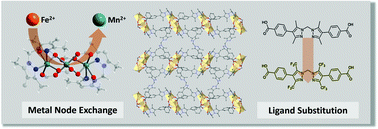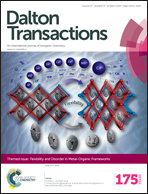Site-specific metal and ligand substitutions in a microporous Mn2+-based metal–organic framework†
Abstract
The precise tuning of the structural and chemical features of microporous metal–organic frameworks (MOFs) is a crucial endeavour for developing materials with properties that are suitable for specific applications. In recent times, techniques for preparing frameworks consisting of mixed-metal or ligand compositions have emerged. However, controlled spatial organisation of the components within these structures at the molecular scale is a difficult challenge, particularly when species possessing similar geometries or chemical properties are used. Here, we describe the synthesis of mixed-metal and ligand variants possessing the Mn3L3 (Mn-MOF-1; H2L = bis(4-(4′-carboxyphenyl)-3,5-dimethylpyrazolyl)methane) structure type. In the case of mixed-ligand synthesis using a mixture of L and its trifluoromethyl-functionalised derivative (H2L′ = bis(4-(4′-carboxyphenyl)-3,5-di(trifluoromethyl)pyrazolyl)methane), a mixed-ligand product in which the L′ species predominanantly occupies the pillar sites lining the pores is obtained. Meanwhile, post-synthetic metal exchange of the parent Mn3L3 compound using Fe2+ or Fe3+ ions results in a degree of cation exchange at the trinuclear carboxylate-based clusters and metalation at the pillar bispyrazolate sites. The results demonstrate the versatility of the Mn3L3 structure type toward both metal and ligand substitutions, and the potential utility of site-specific functionalisations in achieving even greater precision in the tuning of MOFs.

- This article is part of the themed collection: Flexibility and Disorder in Metal-Organic Frameworks

 Please wait while we load your content...
Please wait while we load your content...